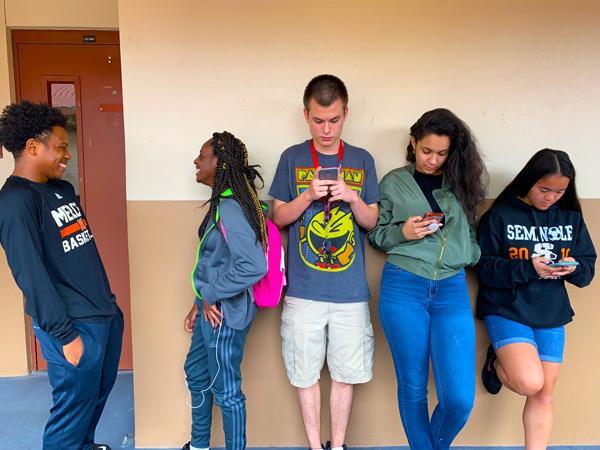POWWOW: IS SOCIAL MEDIA HELPING OR HARMING OUR GENERATION?

Social media can bring people together, but it can also negatively affect students.
November 2, 2018
In this issue of “POWWOW”–The Seminole Newspaper’s debate forum–reporters Samantha Flaute and Suhaib Hasan discuss the merits of social media.
“Social Media Develops a False Sense of Reality”
For many high schoolers, social media is a major part of life, taking up much of her free time. With its growing popularity among millennials, social media composes many life altering threats to our adolescence which should be taken into consideration.
Social media can develop a false sense of reality, where you equate your popularity with your number of likes. This encourages a lack of a filter between what you think and what you say. As a result, this causes many threats to adolescents when exposed to vulgar internet language and interactions which can influence them to make poor choices.
In addition, social media can also lead to communication problems and lack of social interaction as a result of a created persona. It is hard for people to verbally communicate with each other face to face and experience regular human social interactions when they spend their time hidden behind a screen.
Moreover, not all the information shared on social media is true and can lead many people into false conclusions. Bogus information is very prevalent and it is can be hard to find accurate sources. This causes issues when people become misinformed which leads to misunderstandings.
Social media can also have physical effects on your well being. Social media can lead to procrastination, which can hold you back from getting enough sleep. Sleep deprivation is very harmful and can have many unconsidered consequences such as, memory issues, trouble concentrating, high blood pressure, weaken immune system, weight gain, and risk of chronic diseases like heart disease. In addition, social media can be very addictive as it has tendencies to releases endorphins. This same endorphin release process is similar to those who abuse opioids and those who are addicted to smoking.
However, the most dangerous effect of social media by far is cyber bullying. Adolescents are the most vulnerable target among social media bullies. Cyber bullying is a very topical issue which has many deadly effects such as depression and suicide. Cyber bullying is also very popular among social media users. This kind of bullying can lead to body image issues and denigrating self confidence issues which pose a threat for most developing teenagers worldwide.
Sophomore Julio Roman said,“Cyber bullying is a serious topic that needs to be addressed and I feel bad for people being bullied online because you don’t always know the person could be going through.”
Social media when abused can have many pressing and unconsidered side effects. Each year many suffer in silence from humiliation, bullying, and embarrassment as a result of social media abuse. If you notice that someone you know is being bullied over social media speak to a adult or trusted guardian to resolve the issue and if you are using social media be respectful to other users and be cautious of the power of your words.
by Samantha Flaute
“Students Create Online Communities to Share Information”
We live in a generation vastly different from that of our parents due to the omnipresence of technology. While this transition may be daunting, this does not necessarily mean that it is bad.
With 312 million people in the United States with access to the Internet, the burst in growth of social media was an obvious outcome. However, the increased use of media has had an effect on all ages, primarily students. A large argument is that social media has negative impacts on students. Evidence for this claim tend to include the idea that social media and the internet are breeding grounds for cheating. This is a concept that is not agreed with by students themselves.
“Social media helps me [with] being a student in many ways. For example, when I needed to study for a biology test, I use Snapchat to coordinate a study session,” said junior Aniketh Guduri, when asked about how they feel social media affects them.
Students take advantage of the connections created by the use of social media. Along with this, it is more convenient to use for students. They use it to stay in touch with their fellow classmates as to stay on track with their school work.
When asked which different social media sites she uses, and for what reason, junior Aakriti Shah said, “I use Snapchat, Instagram, and Twitter. It helps me to keep in touch with my friends and discuss about the homework and assignments.”
Social media is not only limited to sites like Instagram or Snapchat. Social media is defined as forms of electronic communication through which users create online communities to share information. Any websites that can used to create and share information fall under the umbrella of social media.
Senior Shubham Goel said, “I use different sites like Quizlet to help me make flash cards. I guess I just like the accessibility on my phone rather than having to pull out a bunch of actual index cards.”
The growth of social media has helped students tremendously by creating different study tools to help students succeed on different tests and quizzes. Some of these applications or “apps” can teach foreign languages as well such as the app Duolingo.
by Suhaib Hasan


















